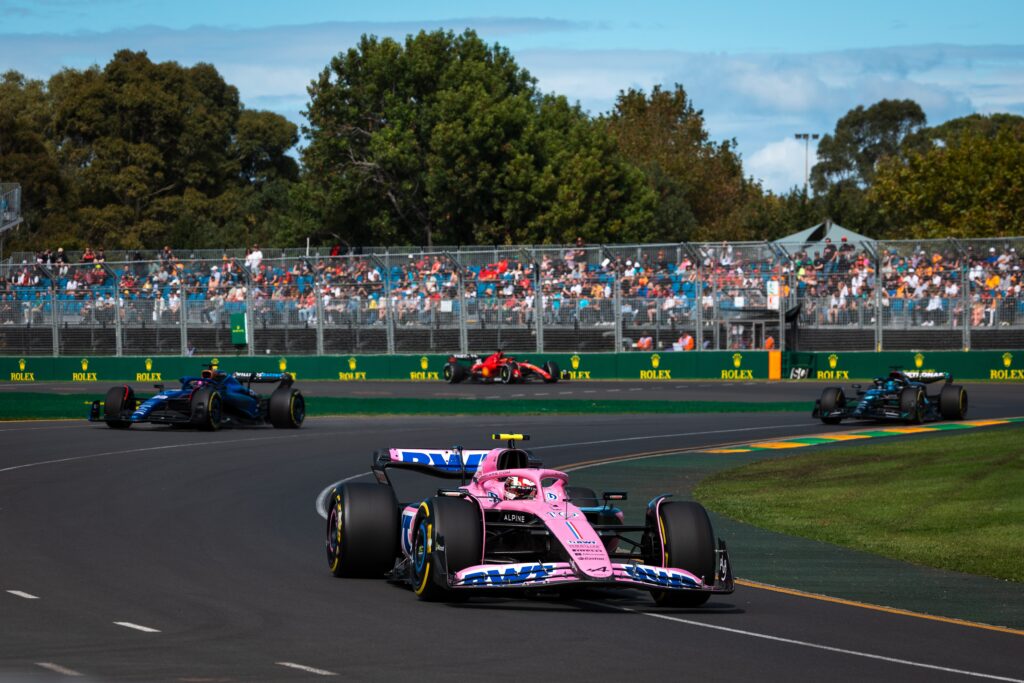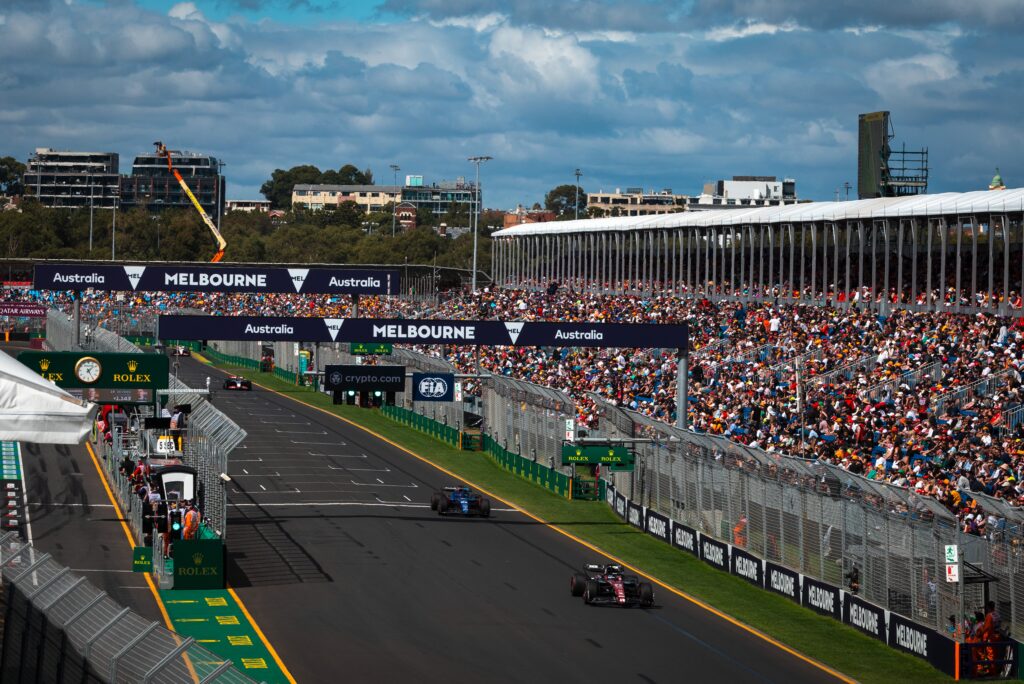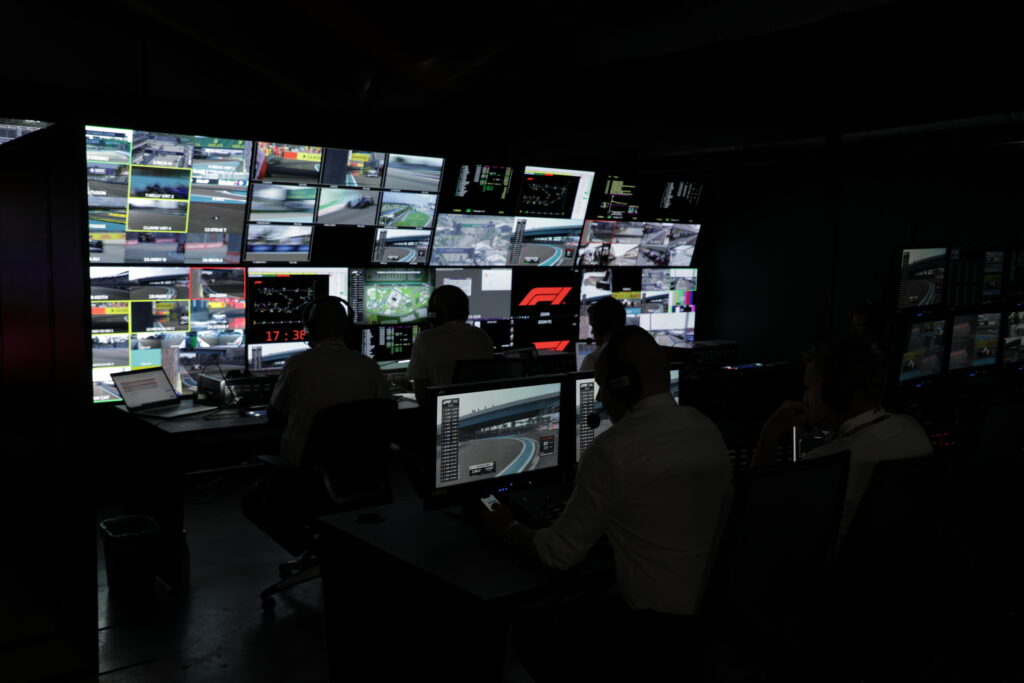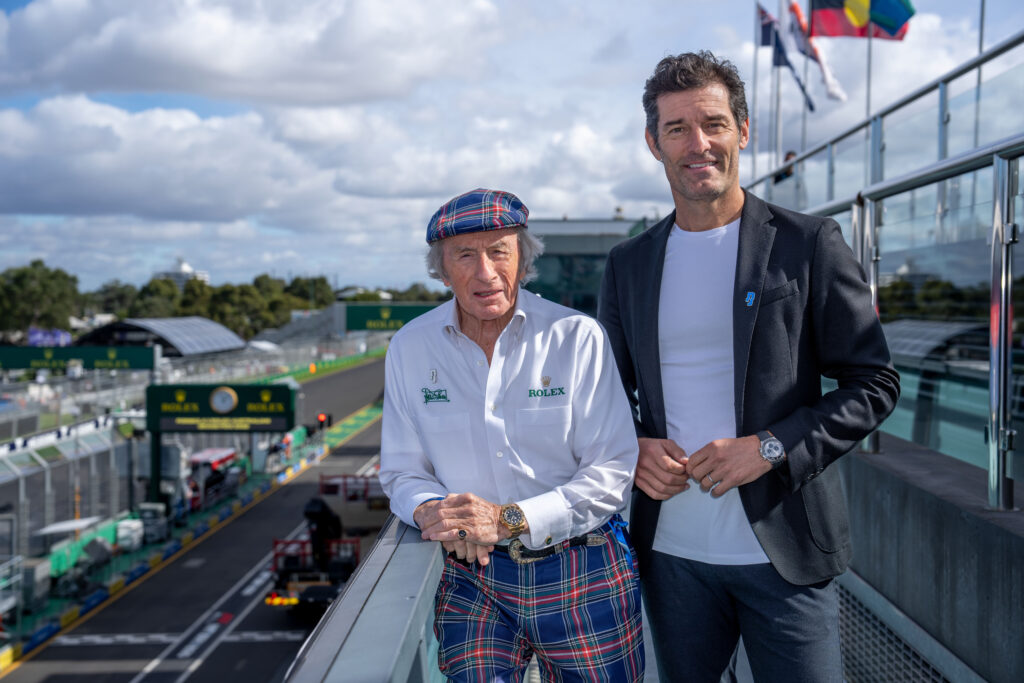Well, that was exciting wasn’t it. In case you missed the drama and hi-jinks at the F1 Rolex Australian GP at Albert Park on the weekend, two-time world champion Max Verstappen claimed top spot on the podium. That much was kind of expected – Verstappen was racing from pole and Red Bull clearly have the fastest car on the grid this year. What wasn’t expected was the manner in which he did it.
To recap, after Mercedes’ George Russell stole an early lead on the Dutchman, contact between Charles Leclerc and Lance Stroll led to a safety car and then a red flag, after which Verstappen reclaimed the lead. The 25-year-old wunderkind looked to be cruising to his first victory Down Under, building an eight-second lead over Mercedes’ Lewis Hamilton, who had been playing cat-and mouse with fellow veteran Fernando Alonso for second place. But just when you thought it was over, Kevin Magnussen hit the wall on lap 56, leading to a second red flag and a re-start from the grid. After a half-hour break the drivers were back out there for a two-lap sprint, only for more carnage in scenes that looked like a smash-up derby, as wheels were sent flying and debris rained down on the track. Eventually, after a historic third restart, Verstappen followed the safety car to victory.
The race had it all – drama, excitement, confusion, head-scratching – all that was really missing was a shoey, though Australia’s own Daniel Ricciardo’s big smile was in full effect as he watched his Red Bull teammates from the sidelines. For long-time fans who regularly get up in the early hours of the morning to watch the sport, the race was nothing too out of the ordinary – F1 has always featured pulsating action, tactical shenanigans and a level of theatre that rivals anything at The Globe, it’s just that now, thanks to Netflix’s smash hit documentary, Drive To Survive, non-rev-heads are waking up to just how thrilling, crazy and sometimes chaotic the sport is.
MH was lucky enough to get an exclusive inside look at what goes on behind the scenes of the F1 travelling circus thanks to major sponsor Rolex. From blink-or-you’ll-miss-them pit changes to observing swarms of mechanics tinker under the hood with the ever-present roar of the most sophisticated engines on the planet wailing in the background, it quickly became clear that despite the hijinks and hoopla, this is a sport that relies on precision timing, mechanical expertise and driver finesse.
Who better, then, to reflect on the rapidly-changing nature of the sport than Rolex’s expert Testimonees, Australia’s own F1 legend Mark Webber (who manages Aussie young gun Oscar Piastri) and three-time world champion Sir Jackie Stewart. Here, they give their expert observations on the current state of F1, its unique relationship with Rolex and why the sport is on something of a roll.

Men’s Health: How does it feel to be back in Melbourne for this year’s GP?
Mark Webber: It just astounds me. The product just gets bigger and better, we’re in this beautiful vortex right now. I think that the event here has earned its stripes and that’s why Formula One love coming here. Australians love coming to the event, it’s been well attended for so long and now we’ve got record crowds. I think this weekend there’s going to be over 400,000 people.
MH: It’s a real festival atmosphere, isn’t it?
MW: Yeah and I think that’s something, when you’ve got this level of acreage, we can offer that’s quite different to some of the other events in Europe. There’s obviously a purpose-built facility. We do a great job with Parks Victoria here, setting it up and pulling it down. All of those engineering and operational challenges are pretty seamless now. I’ve been to some places and it just completely shuts down the whole town. It can be quite challenging. We’re very well versed. It’s very well put together because we’ve had the experience now for so long.
MH: What excites you most about the 2023 season?
MW: Well, I’ve got a personal interest in Oscar [Piastri], obviously. He’s front and centre of my mind, so that’s going to be interesting to watch how he progresses. It’s a big learning curve for him and he’s now with the elite. This is the Everest, if you like – the best drivers in the world, but he’s really enjoying it. I’m still fascinated to see, of course, can Max get a third world title, can Ferrari challenge them? Who can challenge them? Then you’ve got Fernando [Alonso] who is defying age with his performance. So, there are lots of little sub-plots but it’s a long season and we’ll see if anyone can fight Red Bull because the only nervousness about the season is if they just dominate it.
MH: Who are you tipping to win the championship this year?
MW: Max, he’s looking very stable. They’re looking very stable. So, it’s going to be a tough. They [Red Bull] just have no real weaknesses. You might be able to get a shot on him [Max], or land a couple of blows, but over the course of the season, they’re just so experienced. It’s going to be very hard for someone to beat him.
MH: Your association with Rolex is very unique. What makes the brand such a great fit for the sport?
MW: I think they’re certainly hand in glove, in terms of their approach to precision engineering, no compromise. A Rolex watch is a piece of jewellery that will last you a lifetime. Formula One is a sport where they never rest on their laurels. Every week, the best engineers in the world are trying to push the boundaries and improve to produce a better racing car. And when it comes to watch making, there’s no one better in the world than Rolex, in terms of putting out a tremendous range of time pieces that everyone can depend on, rely on and have something that’s so unique but personal, something for yourself. Daytona watches were born out of racing, precision timing and being involved with the Daytona 24-hour race for a long time. Pebble Beach obviously with the golf. Everything that’s elite and exclusive, Formula One and Rolex are all about that.
MH: Yes, there’s a big crossover between watches and motorsport. You’re a watch enthusiast, aren’t you?
MW: There are definitely bigger connoisseurs out there than me. I have a collection I’m pretty proud of, but you’re right, there are some drivers that they are fixated on watches. It’s pretty awesome to listen to them and hear how excited they are to have something so unique. I’ve got my first GMT that I bought for myself after I won my first race in 2009, which is still very special to me. It was just a simple entry point for me. I bought it as a gift to myself, I suppose, for the hard work that I’d put in. After God knows how many years, decades of hard work, I thought, “I’m going to grab this”. I bought it in Austria and I’ve got it to this day. I’ve actually got it here this weekend.
MH: Well earned.
MW: Yeah. And, of course, it will last forever. And I have a Daytona Oysterflex. It’s so funny, I always sleep with my watch on. Sometimes I go cycling and I’ve still got my watch on. I just like how comfy it is. Of course, it’s crazy elegant in terms of how it fits on the wrist and it’s subtle but really classy.

MH: What is it about Daytona that drivers seem to be drawn to?
MW: I think it’s the racing heritage. It’s born out of that precision. You do multiple timings in multiple cars, so that was quite cool for a long time. It was really one of the first watches that you’d do that with. And the mechanics of the watch are so reliable, so dependable. Precision timing is so important in motor racing. Racing drivers want that to be perfect, every single time.
MH: Split seconds really count, don’t they?
MW: Tenths, absolutely.
MH: Let’s talk about the recent season of Drive to Survive with Oscar. How do you feel about him being profiled on the show?
MW: It’s been positive. Obviously, it’s not aimed at the people in the business. It’s aimed at the new audience. We’re in it, we understand it. The sport has never had a wider demographic in terms of people watching it. Especially the female audience, 17-year-old girls, 18-year-old girls, through to my next-door neighbour, my Mum’s friends who are like, “I’m watching it”. It’s incredible how many people now are watching the sport because of that. And then I think you’ve got partners like Rolex, who make an event like today possible. This is actually the 10th anniversary of Rolex being associated with sport, so I think that Liberty have understood that partnering with world-class brands like Rolex and the digitalisation of the sport in terms of socials and going into different demographics and really book ending the top end, the incredible sophisticated exclusive market who have always been drawn to the sport, down to educating the people who are new to the sport. There’s no sport in the world that has done it better. Other sports are trying.
MH: Yeah, they’re all trying now, aren’t they?
MW: But Formula One was pioneering in its thinking with the support of key partners, like Rolex, who understand how we can spread the reach of the sport and be pliable. It’s great for the sport to be more understood globally, which it clearly is now. It’s never been bigger.
MH: Tennis and golf are trying but they haven’t got quite the same drama, right?
MW: It’s a fascinating thing and this is a question you’d have to ask the 10,000 women that come here, but I think the risk component is quite fascinating to them. Obviously in tennis and golf you have the precision. I’m a huge tennis fan, I watch golf. But I think that extra layer of risk is something that is quite appealing for people to watch.
MH: That’s interesting. How did you manage risk and opportunity in your career?
MW: It’s always a fine line. We love the adventure into the unknown, of course. We like the unpredictable nature of what might be around the corner. Of course, we’re highly skilled, we have a lot of experience, we don’t take reckless risks because we have a natural inbuilt sense of self-preservation. But, of course, it’s a sport where the speeds are high and there’s a tight rope of making sure you’re right on the ragged edge. It’s so rewarding when you’re like, Okay, so I’ve just taken those huge risks, but when I do it again the risk becomes less because I’m getting more experienced. I’m nudging that risk bar a little bit closer to the limit, so that’s super rewarding. Risk, reward, skill, homework, being uber professional, all those things give you confidence. But it’s important that you find the sweet spot.
MH: Given you were already a big Rolex fan, you must have been thrilled to become one of their Testimonees back in 2017?
MW: Oh God, when they approached me, it was a pretty big moment. I’ve known Jackie for a long time so it was nice to work with him. Tom Christiansen, Jensen Button, we’re all really, really tight mates. But when I won the World Championship in ’15 in sports cars and they said, “We’d love you to come on board”, I’m like, “Absolutely love to. Love to be involved”. It was pretty unique going to Geneva HQ. It’s probably one of the most impressive facilities I’ve been to in my life. To see where they make the watches, it’s absolutely mind blowing. To play a small role with other elite athlete Testimonees around the world, to be one of those is special, because it is really a unique club.

MH: Obviously you’re still intimately involved in F1 with Oscar, but what do you miss about racing itself?
MW: The camaraderie. You’re working with the team on a project where you know you might catch the opposition out. They might not see something coming and then you’ve got one over them, which is always nice. When I finished at Red Bull there were a thousand people on the team, so it’s a big project. The drivers are the arrowhead for that, our body language, our professionalism, how we go about our work, we’re a big statement for the team.
But I don’t miss racing at all. I don’t miss driving. I don’t miss putting my race suit on, my helmet, any of that. But when I see the mechanics bond and pit stops when everything comes together, it’s like an orchestra. When we pull together a clean weekend from Thursday to Sunday, because they’re starting now, any mistakes can be made now that will affect the race outcome. So, it’s about that build up to perfect execution, which makes it really rewarding.
MH: You’re a former MH cover guy. What do you do to stay in shape these days?
MW: I enjoy my running. I’m managing a few little niggles here and there, but I’ve got a few mates around the world in the special forces and they’ve got very, very challenging injuries, so if I struggle to get out the door, then I’ve got a real problem. I need to be able to draw inspiration from other people who don’t have some of those choices, which I do, often. But I love running, some swimming, a bit of cycling. I love the outdoors. I hate gyms. I can’t remember the last time I went into a gym. I don’t run with music. I don’t run with podcasts. I just go out there and be really present with myself. And the mountains as well. I’ve done some massive hikes in Europe, overnight camping. I like to strip it right back. Open fires, running with my dogs. That, for me, is absolutely perfect. I can do that for the rest of my life.
MH: Funny how we come back after complicating things in our life and just strip it all back and simplify things.
MW: I’ve never owned earphones in my life. Or a smart watch or any of that stuff. No apps. I’ve never been on Facebook in my life. I’m not on Twitter anymore. I do a little bit of Instagram but I wouldn’t know how Facebook works.
MH: You’re not missing much.
MW: Exactly. I think being around people you love is the most important thing. It’s really crucial that people realise how lucky they are to be mobile and draw inspiration from other people who are in trickier situations and yet they’re just so uber positive. I’ve got mates that are in wheelchairs, they are double or triple amputees and these guys are just amazing. Just so positive and they’re out there chasing, giving it everything, which is awesome.

Sir Jackie Stewart
MH: An honour to be here with you, Sir Jackie. You’ve had a relationship with Rolex for 50 years now, is that right?
Sir Jackie Stewart: Yes, more than 50 years.
MH: Why do you think that relationship has stood the test of time?
SJS: All the things that Rolex have are so rare. You cannot buy a Rolex watch at the present time, they’re so popular. If you want the Daytona right now, it’s maybe a year? It’s a great company, very conservative, beautiful product and that’s why it’s such a good marriage, with Formula One, because of their attention to detail and their constant drive to change. Formula One are great at that. Rolex are like that. It’s just been a very happy relationship. I’m the oldest contracted person with Rolex. Arnold Palmer and I signed the same day.
MH: Wow.
SJS: And Arnold has gone now, of course. But that was before Jack Nicklaus, before Gary Player, they’re both around and they’re both Rolex people still. Rolex are a company, unless you’ve been really stupid, as long as you deliver for them, you’ll be there. And I’m an example of that. I live in Switzerland, I’m Scottish but I live in Switzerland. But it’s a big story, a German who started Rolex, started it in England and then found out there wasn’t anyone in England who could do watches so he moved to Geneva. It’s a foundation, it’s not a normal company.
MH: Can you tell us about your first Rolex?
SJS: Well, I did quite well in Indianapolis and qualified in 1966. And it was a Texan that owned the car and he said, “Oh Jackie, come to Texas”. One of these rich Texans, an oil man, his daddy was one of the original oil men. And he took me to Houston, Texas, to this Rolex store, and he said, “I’ve got a surprise” and he gave me one just like this one here [points at wrist]. This isn’t the one. The first one was stolen.
MH: What a shame.
SJS: I’ve got quite a few Rolexes now. It’s an amazing company, quite amazing.
MH: As a legend of the sport, how do you feel about F1 today, compared to when you were a driver?
SJS: Well, it’s hugely different. When I started, if you were a racing driver, one in four of us died. It was crazy, all my friends are dead. Fifty-seven of my friends. There were no medical facilities, it was just crazy. Now, we have the best medical facilities and staff of any sport in the world. I changed motor racing safety. And then Professor Sid Watkins came in and he and I worked together. I started it off and then you needed somebody very proficient. I made myself very unpopular. I closed the Nürburgring race in Germany and we closed the Dutch Grand Prix because they wouldn’t do one single thing, they would not do it. I was very unpopular. I had death threats. But now, we don’t have deaths. It’s been a long time since we’ve had a death in Formula One. Only a few get injured and I hope it always stays like that. The top part of a Formula One car now is a survival shell. Unbelievable. I love the sport enormously. It’s a lovely family and I have so many friends now.
MH: Drive To Survive has brought so many new fans to the sport. Are you a fan of the show?
SJS: Absolutely! Great name. It helped sell out the Vegas GP, which is the last Grand Prix of the year. You couldn’t get a ticket. It’s sold out here. I think it’s because everybody drives a car. And it’s men and women now. When I was driving, the guy would come home from work on a Friday and say, “Darling, Willie and I are going to the Grand Prix at Silverstone”. The wife would say, “Am I going?” “No, you’re not going, it’s a boy’s thing.” Times have changed.
By the way, if I could mention my charity, Race Against Dementia. My wife, Helen, she was my timekeeper and we’ve got three or four PhDs that we brought out here to this country. We’ve got an event on tonight where we’ll raise a lot of money and it all goes to Race Against Dementia. Each country that we go to, we put the money into a PhD, a young professor in each country.
MH: That’s awesome. Okay, last question. What excites you about F1’s future?
SJS: Power and noise, the speed, the limits. Man against machine.
Men’s Health was a guest of Rolex: rolex.com
















